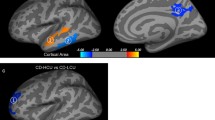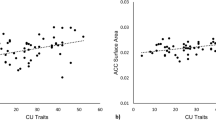Abstract
Among youths with conduct disorder, those with callous-unemotional traits are at increased risk for persistent antisocial behaviour. Although callous-unemotional traits have been found to be associated with white-matter brain abnormalities, previous diffusion imaging studies were conducted in small samples, preventing examination of potential sex by callous-unemotional traits interaction effects on white matter. Here, we used tract-based spatial statistics at a whole-brain level and within regions of interest to compare the white matter correlates of callous-unemotional traits in female vs. male youths with conduct disorder, in a sample (n = 124) recruited through a multi-site protocol. A sex-specific association between callous-unemotional traits and white matter was found in the left uncinate fasciculus, where callous-unemotional traits were positively associated with axial diffusivity in males, while an opposite pattern was found in females. These findings are in line with previous studies suggesting that the uncinate fasciculus is a key tract implicated in the development of psychopathy, but also add to recent evidence showing that sexual dimorphism needs to be taken into account when examining the structural correlates of mental disorders in general, and callous-unemotional traits in conduct disorder in particular.

Similar content being viewed by others
References
American Psychiatric Association. (2013). Diagnostic and Statistical Manual of Mental Disorders (5th ed.).
Bolhuis, K., Viding, E., Muetzel, R. L., El Marroun, H., Kocevska, D., White, T., Tiemeier, H., & Cecil, C. A. M. (2019). Neural profile of callous traits in children: A population-based neuroimaging study. Biological Psychiatry, 85(5), 399–407.
Caldwell, B. M., Anderson, N. E., Harenski, K. A., Sitney, M. H., Caldwell, M. F., Van Rybroek, G. J., & Kiehl, K. A. (2019). The structural brain correlates of callous-unemotional traits in incarcerated male adolescents. NeuroImage. Clinical, 22, 101703.
Cecil, C. A., Lysenko, L. J., Jaffee, S. R., Pingault, J.-B., Smith, R. G., Relton, C. L., Woodward, G., McArdle, W., Mill, J., & Barker, E. D. (2014). Environmental risk, oxytocin receptor gene (OXTR) methylation and youth callous-unemotional traits: A 13-year longitudinal study. Molecular Psychiatry, 19(10), 1071–1077.
Craig, S. G., Goulter, N., & Moretti, M. M. (2021). A systematic review of primary and secondary callous-unemotional traits and psychopathy variants in youth. Clinical Child and Family Psychology Review, 24(1), 65–91.
Jones, D. K., Knösche, T. R., & Turner, R. (2013). White matter integrity, fiber count, and other fallacies: The do’s and don’ts of diffusion MRI. NeuroImage, 73, 239–254.
Maurer, J. M., Paul, S., Anderson, N. E., Nyalakanti, P. K., & Kiehl, K. A. (2020). Youth with elevated psychopathic traits exhibit structural integrity deficits in the uncinate fasciculus. NeuroImage : Clinical, 26.
Meffert, H., Thornton, L. C., Tyler, P. M., Botkin, M. L., Erway, A. K., Kolli, V., Pope, K., White, S. F., & Blair, R. J. R. (2018). Moderation of prior exposure to trauma on the inverse relationship between callous-unemotional traits and amygdala responses to fearful expressions: An exploratory study. Psychological Medicine, 48(15), 2541–2549.
National Collaborating Centre for Mental Health (UK) & Social Care Institute for Excellence (UK). (2013). Antisocial behaviour and conduct disorders in children and young people: Recognition, Intervention and Management. British Psychological Society.
Puzzo, I., Seunarine, K., Sully, K., Darekar, A., Clark, C., Sonuga-Barke, E. J. S., & Fairchild, G. (2018). Altered White-matter microstructure in conduct disorder is specifically associated with elevated callous-unemotional traits. Journal of Abnormal Child Psychology, 46(7), 1451–1466.
Raschle, N. M., Menks, W. M., Fehlbaum, L. V., Steppan, M., Smaragdi, A., Gonzalez-Madruga, K., Rogers, J., Clanton, R., Kohls, G., Martinelli, A., Bernhard, A., Konrad, K., Herpertz-Dahlmann, B., Freitag, C. M., Fairchild, G., De Brito, S. A., & Stadler, C. (2018). Callous-unemotional traits and brain structure: Sex-specific effects in anterior insula of typically-developing youths. NeuroImage: Clinical, 17, 856–864.
Rogers, J. C., Gonzalez-Madruga, K., Kohls, G., Baker, R. H., Clanton, R. L., Pauli, R., Birch, P., Chowdhury, A. I., Kirchner, M., Andersson, J. L. R., Smaragdi, A., Puzzo, I., Baumann, S., Raschle, N. M., Fehlbaum, L. V., Menks, W. M., Steppan, M., Stadler, C., Konrad, K., … De Brito, S. A. (2019). White matter microstructure in youths with conduct disorder: Effects of sex and variation in callous traits. Journal of the American Academy of Child and Adolescent Psychiatry, 58(12), 1184–1196.
Sarkar, S., Craig, M. C., Catani, M., Dell’acqua, F., Fahy, T., Deeley, Q., & Murphy, D. G. M. (2013). Frontotemporal white-matter microstructural abnormalities in adolescents with conduct disorder: A diffusion tensor imaging study. Psychological Medicine, 43(2), 401–411.
Sarkar, S., Dell’Acqua, F., Froudist Walsh, S., Blackwood, N., Scott, S., Craig, M. C., Deeley, Q., & Murphy, D. G. M. (2016). A whole-brain investigation of White matter microstructure in adolescents with conduct disorder. PLoS One, 11(6), e0155475.
Smith, S. M., Johansen-Berg, H., Jenkinson, M., Rueckert, D., Nichols, T. E., Miller, K. L., Robson, M. D., Jones, D. K., Klein, J. C., Bartsch, A. J., & Behrens, T. E. J. (2007). Acquisition and voxelwise analysis of multi-subject diffusion data with tract-based spatial statistics. Nature Protocols, 2(3), 499–503.
Tromp, D. P. M., Williams, L. E., Fox, A. S., Oler, J. A., Roseboom, P. H., Rogers, G. M., Benson, B. E., Alexander, A. L., Pine, D. S., & Kalin, N. H. (2019). Altered Uncinate fasciculus microstructure in childhood anxiety disorders in boys but not girls. The American Journal of Psychiatry, 176(3), 208–216.
Viding, E., & McCrory, E. J. (2018). Understanding the development of psychopathy: Progress and challenges. Psychological Medicine, 48(4), 566–577.
Waller, R., Dotterer, H. L., Murray, L., Maxwell, A. M., & Hyde, L. W. (2017). White-matter tract abnormalities and antisocial behavior: A systematic review of diffusion tensor imaging studies across development. NeuroImage. Clinical, 14, 201–215.
Winkler, A. M., Ridgway, G. R., Webster, M. A., Smith, S. M., & Nichols, T. E. (2014). Permutation inference for the general linear model. NeuroImage, 92, 381–397. https://doi.org/10.1016/j.neuroimage.2014.01.060.
Zhang, J., Gao, J., Shi, H., Huang, B., Wang, X., Situ, W., Cai, W., Yi, J., Zhu, X., & Yao, S. (2014). Sex differences of uncinate fasciculus structural connectivity in individuals with conduct disorder. BioMed Research International, 2014, 673165.
Acknowledgements
We thank Dr. Anderson M. Winkler (FMRIB, University of Oxford) for his help implementing PALM (permutation analysis of linear models) and the between-site heteroscedasticity analysis. Thanks also to Ronald Limprecht (IMBI Heidelberg), who established and maintained the phenotypic database. We sincerely thank our participants and their families for taking part in the study and the other members of the FemNAT-CD consortium.
Funding
This study was funded by the European Union’s Seventh Framework Programme for research, technological development and demonstration (FP7/2007-2013) under Grant Agreement no° 602407 (FemNAT-CD; coordinator: Christine M. Freitag). During the writing-up of the manuscript, Stephane A. De Brito was supported by a short-term Invitational Fellowship from the Japanese Society for the Promotion of Science (JSPS - S19103) and an International Academic Fellowship from the Leverhulme Trust (IAF-2019-032).The funding source had no role in the design and conduct of the study; collection, management, analysis, and interpretation of the data; preparation, review, or approval of the manuscript; or decision to submit the manuscript for publication.
Author information
Authors and Affiliations
Contributions
Dr. Villemonteix and Ms. Courbet contributed to analysis and interpretation of the data, drafting the article and revising it for publication with important intellectual content and final approval of the manuscript and agreed to be accountable for all aspects of the work in ensuring that questions related to the accuracy or integrity of any part of the work are appropriately investigated and resolved. Drs. Rogers, Gonzalez-Madruga, Kohls, Raschle, Fairchild, and De Brito all contributed to the conception, design, analysis and interpretation of the data, drafting the article and revising it for publication with important intellectual content and final approval of the manuscript and agreed to be accountable for all aspects of the work in ensuring that questions related to the accuracy or integrity of any part of the work are appropriately investigated and resolved. Profs. Konrad, Stadler, and Freitag provided important interpretation of data, intellectual contribution on drafting the article, and final approval of the version to be published and oversaw all aspects of the work ensuring that the accuracy or integrity of any part of the work was appropriately investigated and resolved.
Corresponding authors
Ethics declarations
The FemNAT-CD study ((4); www.femnat-cd.eu) was conducted in accordance with legal regulations outlined by the European Union, national legislation and the Declaration of Helsinki. Study protocols were approved by local ethical committees at each site prior to data collection: RWTH Aachen University Hospital (EK027/14) for the Aachen site, the Ethics Commission Northwest and Central Switzerland (EKNZ: 336/13) for the Basel site, and the University Ethics Committee (ERGO Number: 18970) and the National Health Service Research Ethics Committee (NRES Committee West Midlands, Edgbaston; REC Reference 13/WM/0483) for the two UK sites (Birmingham and Southampton.
Conflict of interest
Dr. Raschle has received grant support as a Jacobs Foundation Early Career Fellow 2017-2019 (grant no. 2016 1217 13). Prof. Stadler has received royalties for a book on aggression. Prof. Konrad has received speaker fees from Shire Pharmaceuticals and Medice. Prof. Freitag has received royalties for books on Attention-Deficit/Hyperactivity Disorder and Autism Spectrum Disorder. She has served as consultant to Desitin and Roche. Dr. De Brito has received speaker fees from the Child Mental Health Centre and the Centre for Integrated Molecular Brain Imaging. Drs. Gonzalez-Madruga, Rogers, Kohls, Fairchild, Villemonteix and Ms. Courbet report no biomedical financial interests or potential conflicts of interest.
Additional information
Publisher’s note
Springer Nature remains neutral with regard to jurisdictional claims in published maps and institutional affiliations.
Supplementary Information
ESM 1
(DOCX 96 kb)
Rights and permissions
About this article
Cite this article
Villemonteix, T., Rogers, J.C., Courbet, O. et al. Sex matters: association between callous-unemotional traits and uncinate fasciculus microstructure in youths with conduct disorder. Brain Imaging and Behavior 16, 263–269 (2022). https://doi.org/10.1007/s11682-021-00499-4
Accepted:
Published:
Issue Date:
DOI: https://doi.org/10.1007/s11682-021-00499-4




